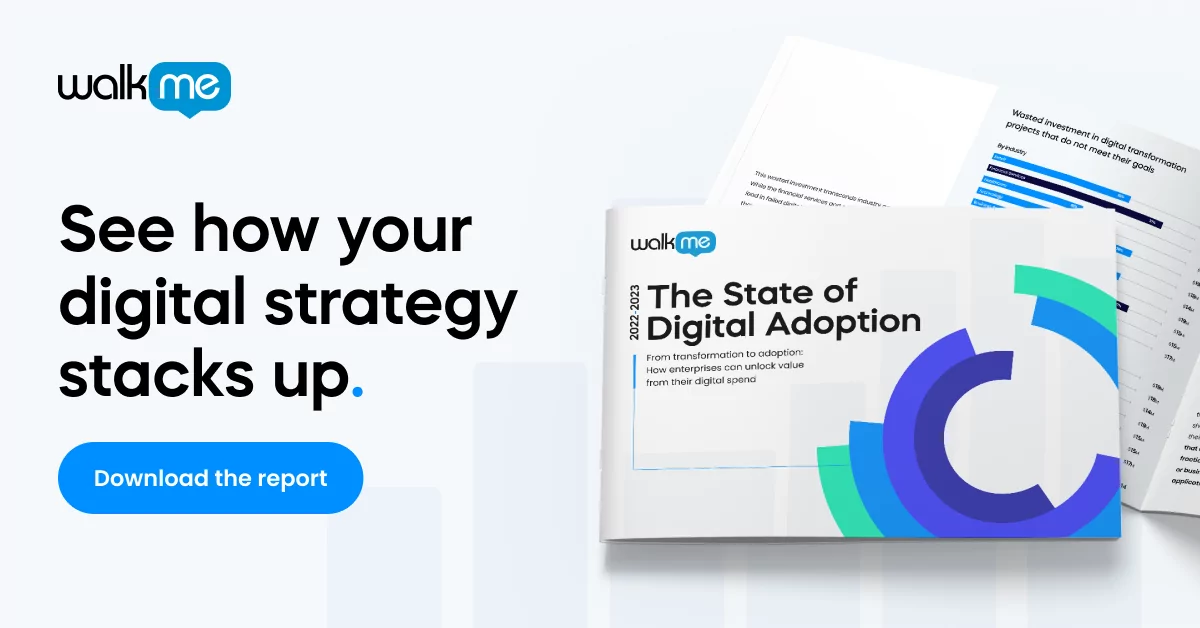When you think of the drivers of digital transformation, what do you picture? Technologies that solve problems, like the Cloud or a new form of AI-driven automation?
If these answers are similar to your responses, you’re not alone. The popular perception is that digital transformation drivers mean investment in the tech stack because technology leaders associate the newest solutions with higher performance and profits. But this thought process misses the bigger picture.
Before investing in new digital transformation technologies, you must consider what drives the decision to adopt these new technologies. The importance of this question is why we have provided this list of digital transformation drivers for 2023.
This article will help you identify digital transformation drivers, why they are essential to business processes, and our list of the top seven drivers of 2023. Doing so will give you a general overview of what to expect in 2023 and how to strategically use this information to plan for your organization’s future success as CIOs, IT leaders, or other team members.
What are digital transformation drivers?
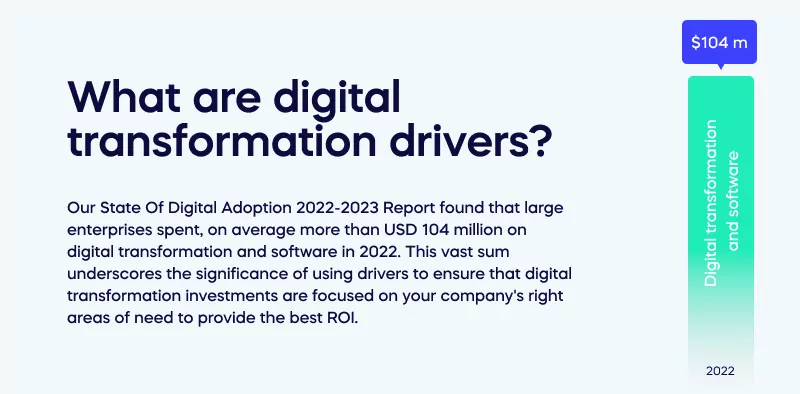
Digital transformation drivers are the reasons for using new digital tools. Drivers help you identify problems or obstacles to profit generation, showing you where to make changes that will allow you to reduce operational efficiencies and boost performance and ROI by investing in new digital technology. It is essential to know that utilizing transformation drivers goes beyond technology, but the first step is looking at what needs changing, how, and why.
Our State Of Digital Adoption 2022-2023 Report found that large enterprises spent, on average more than USD 104 million on digital transformation and software in 2022. This vast sum underscores the significance of using drivers to ensure that digital transformation investments are focused on your company’s right areas of need to provide the best ROI.
Next, let’s look at the difference between digital transformation drivers and enablers, as these can be easily confused.
Digital transformation drivers vs. enablers
It is easy to confuse digital transformation drivers with enablers. The difference is that drivers help you see the problems that transformation technologies must solve, and enablers solve these problems.
For example, a driver for a new streaming service startup might be a new business model, which identifies that the company is not successful because they are using a subscription business model. The enabler would be the technology that allows the new company to shift to a freemium model, satisfying users’ needs and boosting revenue.
Now we understand the difference between digital transformation drivers and enablers, let’s look at how drivers are essential to business processes.
How are digital transformation drivers essential to business processes?
In the coming years, changes in consumer behavior will become a deciding factor when it comes to increasing value in retail stores more than any other single element. This point is part of why our State Of Adoption Report found that 67% of organizations are under “incredible pressure” to accelerate digital transformation. Through digital transformation, companies can use data and technology to provide better services for customers and internal stakeholders. It’s also essential that the technology should support and optimize existing procedures without altering their operations too much.
In today’s world, individuals have grown accustomed to the benefits and comfort that technology has provided. People enjoy being present in the customized digital realm where they can obtain real-time information, expecting retailers to keep up with such demands. To stay ahead of these changes, brands can use innovative technology as an opportunity for growth and transformation to meet customers’ needs.
7 critical digital transformation drivers in 2023
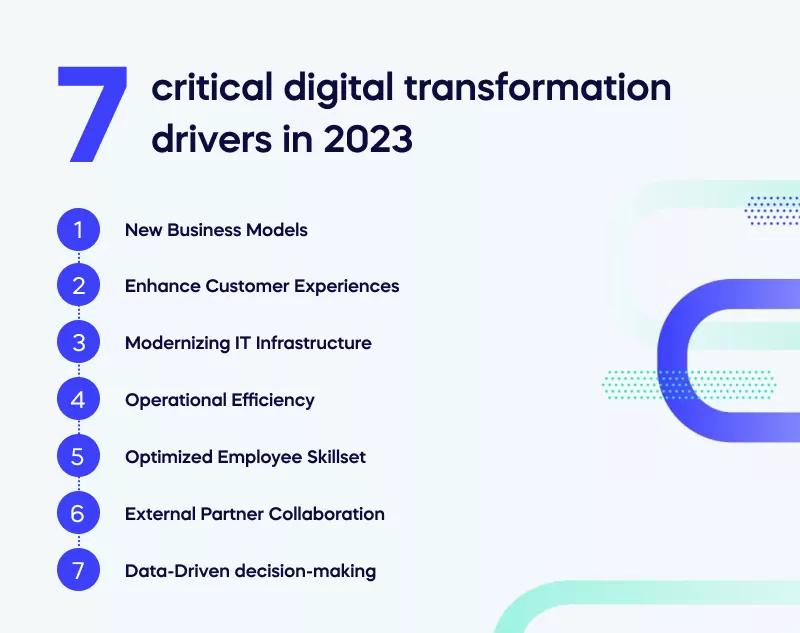
It is helpful to plan to identify the key drivers of transformation relevant to your company at the start of each year to ensure that you remain competitive and digitally resilient for the future.
Luckily, for the year ahead, we have done the work for you as we present the seven key drivers of transformation in 2023:
-
New Business Models
-
Enhance Customer Experiences
-
Modernizing IT Infrastructure
-
Operational Efficiency
-
Optimized Employee Skillset
-
External Partner Collaboration
-
Data-Driven decision-making
Digital adoption is a vital part of digital transformation, which involves internalizing and utilizing new technologies and tools by teams throughout the company. Organizations can ensure their digital transformation initiatives are successful by training employees, improving processes, and leveraging data collection methods.
We will now take a more in-depth look at the driver for digital transformation in 2023.
-
New Business Models
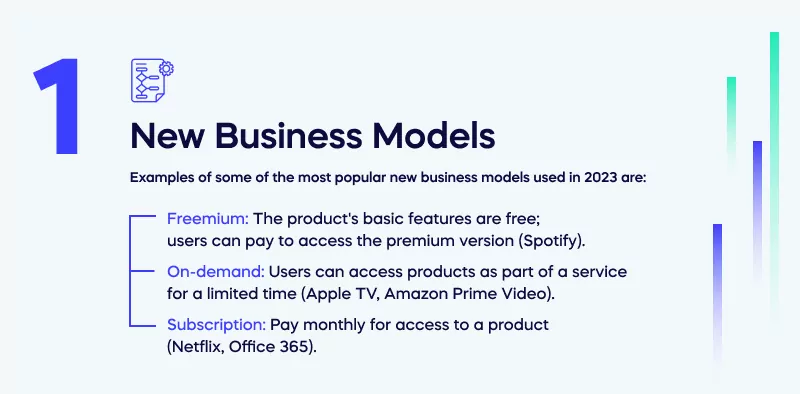
Harness the power of next-generation breakthroughs like adaptive artificial intelligence (AI) and revolutionize your customer experience! AI tools like chatbots can instantly answer any site visitor’s query. Moreover, it can recognize different forms of the question and gives customized responses in your preferred voice and style.
Digital business models that design customer benefits with technological advancements are the future of value creation. Through digital solutions, companies can reap the rewards such as enhanced user acquisition and improved products/services. These cutting-edge innovations have the potential to revolutionize your company’s operations from end to end – so seize this opportunity and optimize it to your needs.
Examples of some of the most popular new business models used in 2023 are:
-
Freemium: The product’s basic features are free; users can pay to access the premium version (Spotify).
-
On-demand: Users can access products as part of a service for a limited time (Apple TV, Amazon Prime Video).
-
Subscription: Pay monthly for access to a product (Netflix, Office 365).
By considering what business model is best for your products and services, you reach your target market by making the right choices in your digital transformation to maximize ROI.
-
Enhanced User Experiences
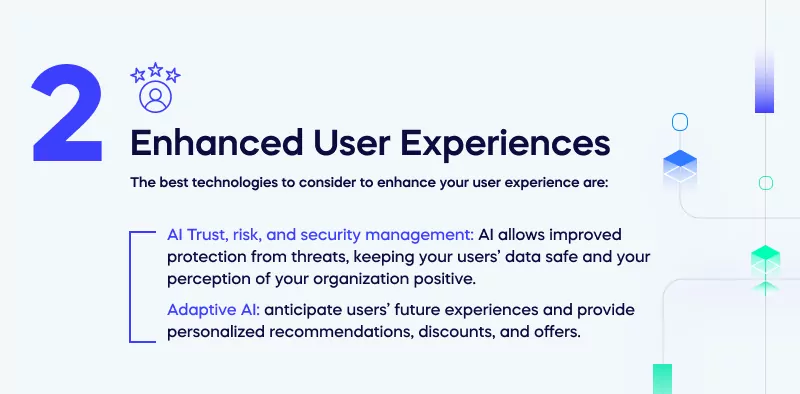
Nowadays, technology users have grown accustomed to a certain level of convenience in their day-to-day activities. Whether they are making purchases online, streaming videos, or banking on mobile devices – the exact expectations exist when using products, services, and platforms at work. As such, people subconsciously anticipate having an excellent user experience while engaging with business resources.
The best technologies to consider to enhance your user experience are:
-
AI Trust, risk, and security management: AI allows improved protection from threats, keeping your users’ data safe and your perception of your organization positive.
-
Adaptive AI: anticipate users’ future experiences and provide personalized recommendations, discounts, and offers.
The user experience must remain a primary focus for all organizations, as it will directly influence their revenue. By maximizing this interaction, businesses can optimize performance and improve satisfaction.
-
Modern IT Infrastructure
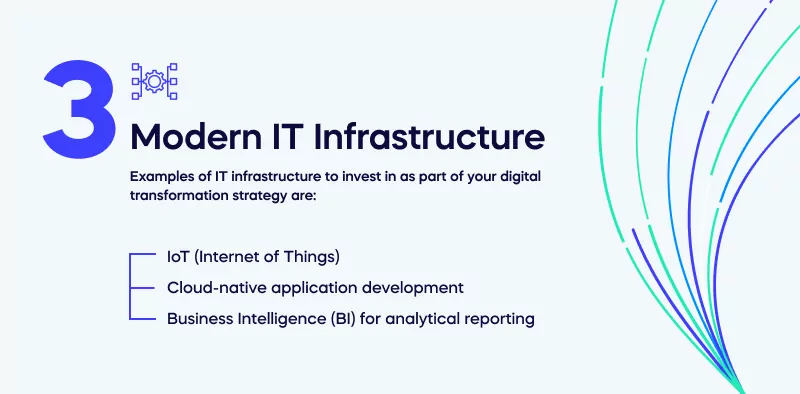
Even though legacy IT infrastructure, obsolete technology applications, and systems reaching their lifespan have become critical aspects of daily operations in most organizations, they remain obstacles to scalability, support, interoperability, and growth.
Upgrading these outdated components with advanced technological solutions is essential to revive digital transformation efforts.
Examples of IT infrastructure to invest in as part of your digital transformation strategy are:
-
IoT (Internet of Things)
-
Cloud-native application development
-
Business Intelligence (BI) for analytical reporting
-
Operational Efficiency
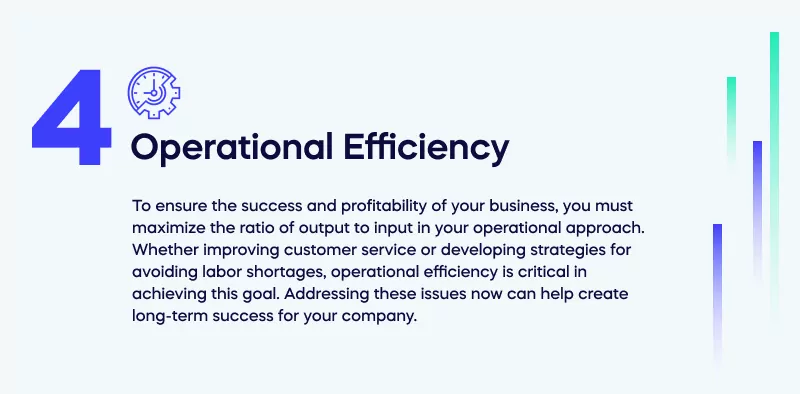
To ensure the success and profitability of your business, you must maximize the ratio of output to input in your operational approach. Whether improving customer service or developing strategies for avoiding labor shortages, operational efficiency is critical in achieving this goal. Addressing these issues now can help create long-term success for your company.
By streamlining operations and maximizing efficiency, a business can reap the benefits of lower staffing costs while still maintaining an agile stance to tackle any obstacles it may encounter in the future.
Streamlining the workflow to ensure accuracy and simplicity is a breeze when organizations embrace automated solutions. Such technologies can help companies save time, money, and energy while providing accurate results.
Harnessing the power of technology to facilitate new applications, automated systems, and API services can help bolster your business operations. Companies can maximize their potential and exploit optimization opportunities by integrating applications/systems with batch processes using digitization.
-
Optimized Talent Acquisition
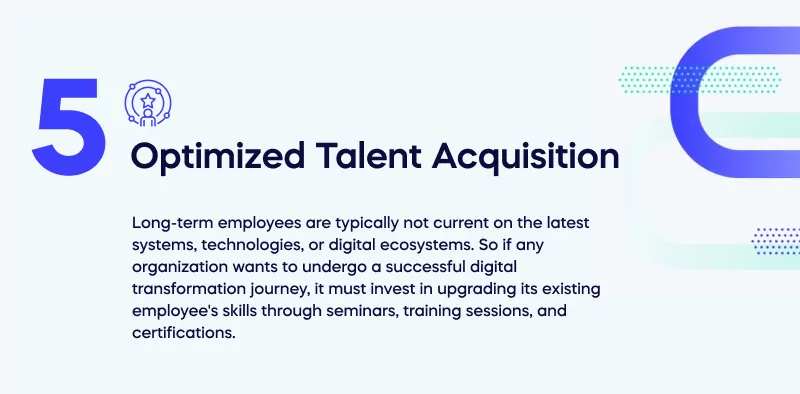
Long-term employees are typically not current on the latest systems, technologies, or digital ecosystems. So if any organization wants to undergo a successful digital transformation journey, it must invest in upgrading its existing employee’s skills through seminars, training sessions, and certifications. This way, they can stay ahead of the competition with knowledgeable workers who understand modern practices.
They must bring in fresh faces and new talent to fill the gap. Upgrading their current employees’ skillsets and investing in expert resources to set up a smooth digital workflow is essential to their transformation initiatives.
-
External Partner Collaboration
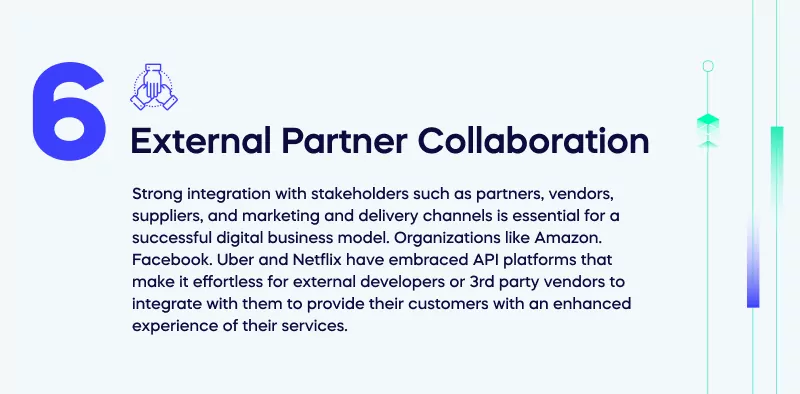
Strong integration with stakeholders such as partners, vendors, suppliers, and marketing and delivery channels is essential for a successful digital business model. Organizations like Amazon. Facebook. Uber and Netflix have embraced API platforms that make it effortless for external developers or 3rd party vendors to integrate with them to provide their customers with an enhanced experience of their services.
Despite this, many organizations hesitate to share data with an external entity. By partnering with outside firms and exchanging information, a company can construct new business models that will result in improved products/services and alternative delivery channels.
-
Data-Driven Decision Making
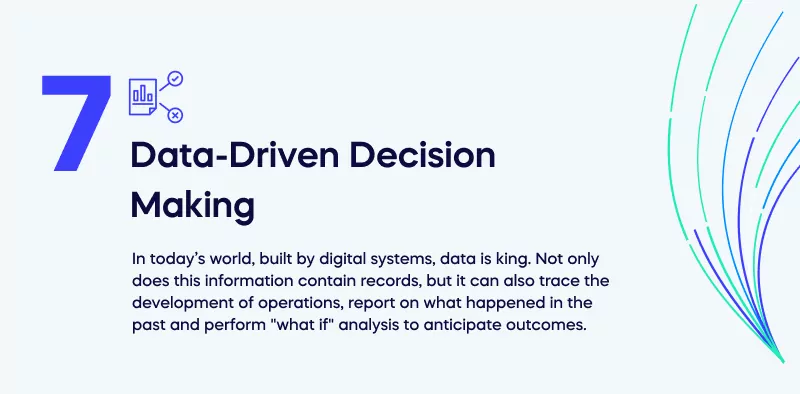
In today’s world, built by digital systems, data is king. Not only does this information contain records, but it can also trace the development of operations, report on what happened in the past and perform “what if” analysis to anticipate outcomes.
When you employ data-driven decision-making in your business strategy, several approaches will influence these decisions. Some of these include:
-
Maximizing your data-driven decision-making process by selecting the business intelligence tool.
-
Making well-informed business decisions with accurate data, measurable metrics, and verifiable facts.
-
Ensuring that all members within the organization have access to data to collaborate on a unified strategy.
-
Learn from past experiences to accurately group historical data and draw meaningful conclusions for the future.
Data-driven decision-making has become an essential tool for digitally savvy business executives who seek better results from their choices. Digital Transformation requires leaders to tap into this powerful resource and use its insight to make informed decisions.
Streamline your digital transformation drivers in 2023 with a DAP
When you become aware of the above drivers, you will consider how to begin implementing them. A digital adoption platform is the best way to help your staff learn new technologies quickly and personally. Our DAP is a market-leading product, so call us today to ensure your digital transformation success, giving you the edge in our increasingly digital world.
